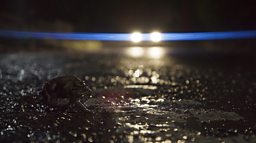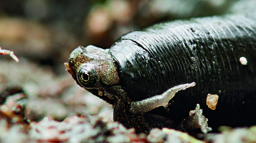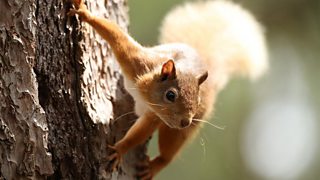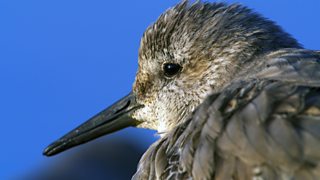Tiny toadlets and lurking leeches - a horror story in the undergrowth
By Lily Moffatt, Assistant Producer
Filming on the new ����ý Wild Isles series spanned majesty, jeopardy, rarity and the down-right weird. Though filming eagles in the pristine Caledonian pine woodlands of the Scottish Highlands is something to behold, for me, it doesn’t get much better than revealing the intimate behaviours of the more obscure creatures that call our Wild Isles home.
So rather than the big, bold and beautiful, let me give you a sneak behind the scenes peak into one of the more weird and wonderful shoots we did.

Historically, toads were known to begin their march around the pertinent date of Valentine’s Day. Toads rouse from their winter slumber when conditions are optimal; damp, moist under foot and with air temperatures at around eight degrees. It is also thought that the moon phase plays into their awakening and migration too and this is exactly what we wanted to film.
as a nation, we are exceptional toad conservationists
Despite being inundated with filming locations, especially local to where I live in Bath, filming this great migratory event turned out to be surprisingly difficult.
Finding toads to film wasn’t a problem - as a nation, we are exceptional toad conservationists. Across the country, toad patrols formed by local communities come together, bonding with bucket in hand, poised and ready to rescue any wondering toad from the human- dominated landscapes that now scar their migration routes.
So with both the Warminster and Winscombe toad patrol on speed-dial, we were ready – primed to hop into action as soon as the tip-off came that the big event was about to happen.

But the reality was sobering – neither toad patrol were seeing the toads in the numbers they might expect, and across the two years we were filming, both patrols reported that numbers were significantly down on previous years. In fact, since the 1970s, toad numbers have been steadily decreasing and in the last 30 years, they have declined by a staggering 68%.
Since the 1970s, toad numbers have been steadily decreasing
It’s not all red roses when it comes to these precious and tenacious little amphibians – but such stark facts made it even more imperative that we included these amorous amphibians in the series.
Toads move faster than you probably think, but when faced with a vehicle travelling at speed on a dark road – they really don’t stand a chance. It’s estimated that approximately 20 tonnes of toad are killed on our roads each year. This was a story we really wanted to play out to our audience, following a determined toad couple crossing a road and the hardships that come with it.
Filming this behaviour took time and patience and our camerawoman Katie Mayhew lay for hours in the wet verges, during the very early hours of the morning, waiting to capture the scene that we were after.

Toads have a built in sat nav; incredibly, these amphibians know exactly where and when to make their journey back to the pools or ponds that they were born into.
Female toads are easily one of the most determined, resilient and tenacious queens of the natural world
Despite the difficulties – by mid-March the little village pond was now brought to life by a chorus of gentle peeps sung out by courting toads. We were now able to film them in the water with a specialised underwater camera – getting a sneak preview into their amphibious and very amorous lives.
Swollen-bellied female toads lay thousands of eggs, packaged in nature’s jellified double-helix assembled necklaces, that lay delicately across aquatic vegetation. Female toads are easily one of the most determined, resilient and tenacious queens of the natural world - a creature that our all-female crew grew to know and love.
Fast forward three to four months and it’s baby toad season. Once the toad tadpole has fully metamorphosed, they emerge from their natal pools and make their journey out into the open. But waiting in the wings is something formidable.
I was shocked to see the leeches eating the toadlets
Naturalist and all-round wildlife guru John Walters sent us to a remote pool in Dartmoor where he’d witnessed some incredible predatory behaviour - leeches that actively hunted the toadlets. I was sceptical when he told me about this encounter, until I visited for myself and witnessed it happening before my very eyes.
The leeches were eating the toadlets!
This was something we really wanted to film for the series, but it only happens over a very short period each year, so it was full steam ahead to get set to film.


Armed with some serious camera gear - and our wonderful cameraman Pete Cayless – we filmed over some of the hottest days of the year. We were rewarded as there were leeches everywhere and thousands of toadlets making a run for it, trying to evade being taken.
lucky for us crew, these leeches don’t drink human blood
The leeches hunting the toadlets are a species called the horse leech. Whilst very little is known about this species, we do know that they possess many teeth, that sit back in their mouth parts – used to chew up their prey after they’ve engulfed it – whole.
Lucky for us crew, these leeches don’t drink human blood as they’re unable to break human skin so none of us met the fate of those toadlets. On occasion though, they did become attached to us when we were looking the other way.
Yes, it was a shock to look down and see one firmly sucked on, but with a little gentleness, they’d soon let go and slink off into the undergrowth. Just call me the leech whisperer.

Dramas like these are unfolding all the time, usually in our back gardens or local parks. You’ve just got to go outside, watch and wait.
For the toads and leeches sequence, it was truly a sight to behold - a perilous journey for the adults to venture and a realisation of how nature self-regulates, unless faced with human obstacles - which are becoming ever more prevalent in our landscape.
So, I urge you all to go and join your local toad patrol (if you’re lucky enough to have one), save a toad or 10 and learn to love a leech too.
Find out more about toad patrols, and




